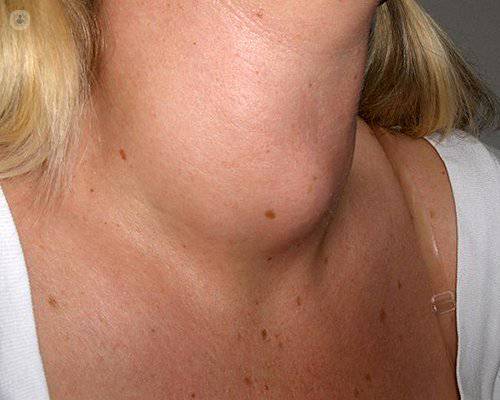
What are goitres?
A goitre is an increase in the size of the thyroid gland. The thyroid is an endocrine gland located in front of the neck that surrounds the trachea and manufactures the thyroid hormone or thyroxin, which is the hormone that regulates the metabolism of the body.

Types of goitres
Basically, there are two types of goitres:
1. Diffuse goitre in which the entire gland is "diffusely" increased in size and is usually related to a malfunction of the gland: Hyperthyroidism or Hypothyroidism.
2. Nodular goitre; the growth, in this case, occurs by the appearance of one or several nodules (tumours or lumps).
When a single nodule appears (Nodular goitre) it can be a malignant adenoma, benign or carcinoma (7-15%). When several nodules appear, we refer to mucinodular goitre (4% malignant).
When the growing goitre is introduced into the thorax below the clavicle and the sternum we call it endothoracic goitre.
Goitre symptoms
Goitre symptoms produced by the growth of the thyroid gland itself are a consequence of the volume and compression of neighbouring structures. Therefore, they can be:
- The appearance of a lump more or less aesthetic on the anterior face of the neck.
- Discomfort or difficulty breathing, coughing, snoring, etc. caused by compression of the trachea.
- Difficulty swallowing caused by compression of the oesophagus.
When goitre growth is rapid it can produce pain or a feeling of oppression. There are other symptoms that are secondary not in "lumps", but the goitre causes symptoms such as hyper or hypothyroidism or signs of malignancy such as voice loss due to an invasion of the laryngeal nerve, appearance of metastases in the ganglia, etc.
What are the risk factors and causes of goitres?
Causes depend on the type of goitre, as mentioned in the case of diffuse goitre it usually appears as a result of malfunction, hyper or hypothyroidism.
Occasionally, thyroiditis, which is an inflammation of the thyroid, often an autoimmune reaction, can also occur with the appearance of goitre.
In ancient times, it was very common to see people with giant goitres, usually caused by iodine deficiency and it was frequent in certain areas of the Mediterranean where there was no iodine in the water or diet of inhabitants: this was referred to as an endemic goitre. Nowadays, with the addition of iodine to salt, goitres have practically disappeared.
Also, in many cases, there is a genetic predisposition that favours the appearance of both benign multinodular goitre and thyroid cancer. The cause of why goitres are much more frequent in females is still unknown.
Radiation is a risk factor for the appearance of nodules in the thyroid and especially of some thyroid cancers. This was learned 20-30 years after the nuclear explosions of Hiroshima and Nagasaki. It was also discovered that radiation therapy, which was used for the treatment of facial acne, sinusitis and other conditions of the face and neck for more than 40 years, was a risk factor for the development of thyroid cancer. For this reason, these treatments have not been used for more than 40 years.
What does goitre treatment involve?
In most cases, goitres can be treated with diet, medication, surgery or radioisotopes. Surgery may be more or less extensive depending on the reason for the intervention. When a patient has a single benign nodule, usually only one of the two lobes (right or left) of the thyroid is removed. If the patient has cancer, all thyroid and ganglia must be removed, with the goitre usually being treated afterwards with radioactive iodine. Patients who have a multinodular goitre also have the entire thyroid gland removed. As in other fields of surgery, we are doing less invasive or aggressive operations, with smaller scars and employing the latest technologies in order to increase the chances of success after thyroid surgery.
How is recovery?
Thyroid surgery is less troublesome than abdominal surgery. It is usually painless; the patient can start eating, talking and getting up normally the same day of the operation. The hospital stay lasts from one to three days and after 8-10 days you can basically return to performing normal, day-to-day activities.

